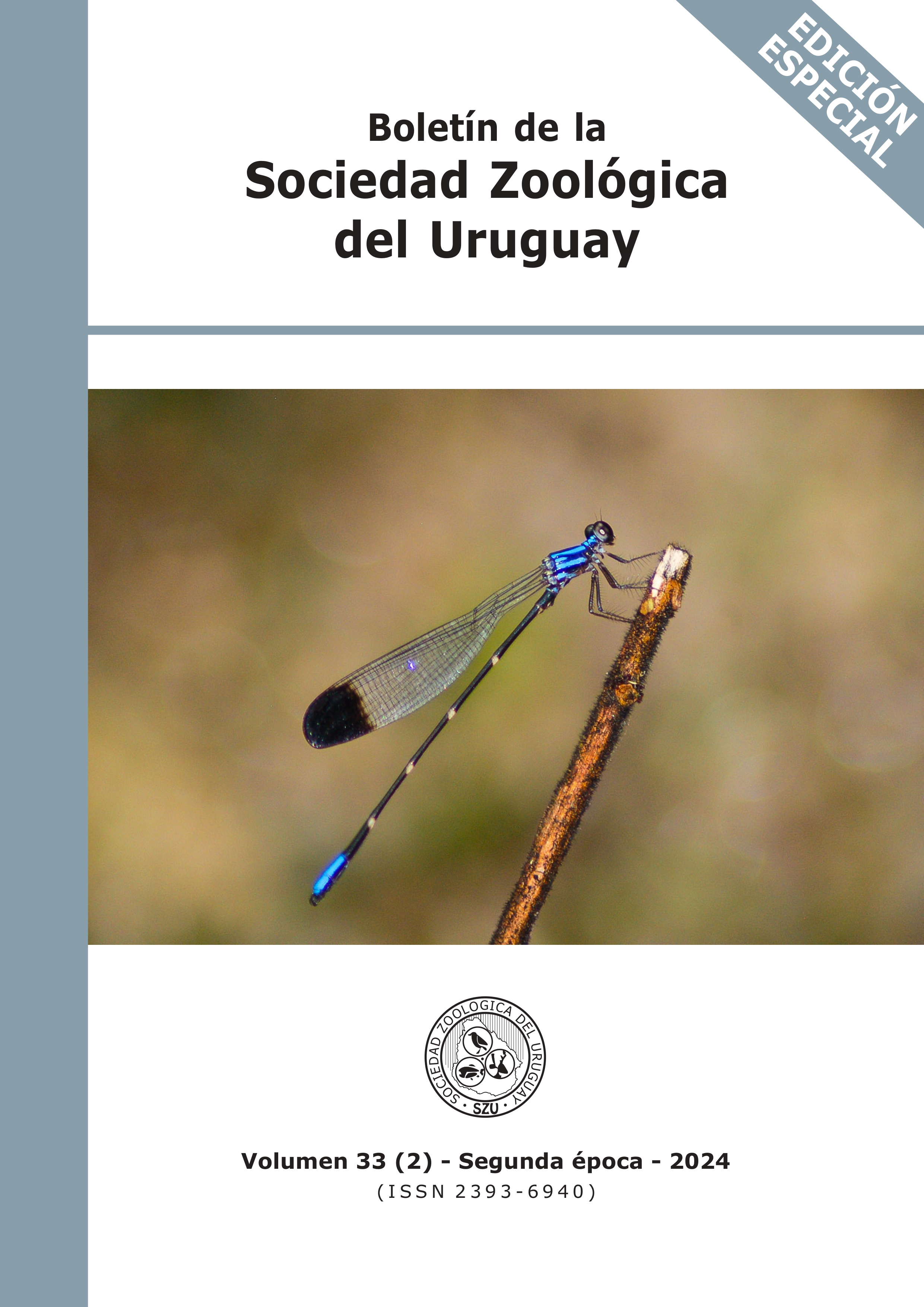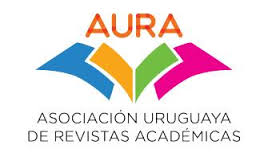ANALYSIS OF WATER QUALITY AND DIVERSITY PATTERNS OF AQUATIC INSECTS OF TWO ENVIRONMENTAL SEASONS IN THE CUITZMALA AND PURIFICACIÓN BASINS, MEXICO
DOI:
https://doi.org/10.26462/33.2.3Keywords:
water quality, aquatic insects, alpha diversity, beta diversityAbstract
In tropical aquatic ecosystems, temporal climate patterns shape environmental conditions and biodiversity. However, the impact of these changes on aquatic communities in the Neotropics has been understudied. This research evaluates how the variation between dry and rainy seasons affects water quality and the alpha and beta diversity of aquatic insects in the Cuitzmala and Purificación river basins in Jalisco, Mexico. The results show a clear influence of the seasons on water quality and insect diversity patterns. During the dry season, higher levels of electrical conductivity, salinity, and dissolved solids are observed, while during the rainy season,
turbidity and phosphate levels increase. Alpha diversity is higher in the dry season, and beta diversity shows greater turnover of insect families in the dry season and greater nestedness in the rainy season. These findings indicate that aquatic communities respond differently to seasonal conditions, which may affect the resilience and ecological stability of these ecosystems.
Downloads
References
Allen, J.D. (2004). Landscapes and Riverscapes: The Influence of Land Use on Stream Ecosystems. Annual Review of Ecology, Evolution, and Systematics, 35, 257-284.
Al‐Shami, S.A., Heino, J., Che Salmah, M.R., Abu Hassan, A., Suhaila, A.H., & Madrus, M.R. (2013). Drivers of beta diversity of macroinvertebrate communities in tropical forest streams. Freshwater Biology, 58(6): 1126-1137.
Anderson, M.J. (2014). Permutational multivariate analysis of variance (PERMANOVA). Wiley Statsref: Statistics Reference Online, 1-15.
Astorga, A., Death, R., Death, F., Paavola, R., Chakraborty, M., & Muotka, T. (2014). Habitat heterogeneity drives the geographical distribution of beta diversity: the case of New Zealand stream invertebrates. Ecology and Evolution, 4(13), 2693-2702.
Astudillo, M.R., Novelo-Gutiérrez, R., Vázquez, G., García-Franco, J.G., & Ramírez, A. (2016). Relationships between land cover, riparian vegetation, stream characteristics, and aquatic insects in cloud forest streams, México. Hydrobiologia, 768, 167-181.
Auquilla, R.C., Astorga, Y., & Jiménez-Otárola, F. (2006). Influencia del uso del suelo en la calidad del agua en la subcuenca del río Jabonal, Costa Rica. Recursos Naturales y Ambiente, 48, 81-92.
Barbour, M.T. (1999). Rapid bioassessment protocols for use in wadeable streams and rivers: periphyton, benthic macroinvertebrates and fish, Washington DC, USA: Environmental Protection Agency.
Baselga, A. (2010). Partitioning the turnover and nestedness components of beta diversity. Global ecology and biogeography, 19(1), 134-143.
Baptista, D.F., Buss, D.F., Dorvillé, L.F.M., & Nessimian, J.L. (2001). Diversity and habitat preference of aquatic insects along the longitudinal gradient of the Macaé River Basin, Rio de Janeiro, Brazil. Revista Brasileira de Biologia, 61(2), 249-258.
Bueno-Soria, J. (2010). Guía de identificación ilustrada de los géneros de larvas de insectos del orden trichoptera de México, Distrito Federal, México: Universidad Nacional Autónoma de México.
Callisto, M., & Goulart, M. (2005). Invertebrate drift along a longitudinal gradient in a Neotropical stream in Serra do Cipó National Park, Brazil. Hydrobiologia, 539, 47-56.
Castro, M.P., Hughes, R.M., & Callisto, M. (2013). Effects of flow fluctuations on the daily and seasonal drift of invertebrates in a tropical river. Annales de Limnologie International Journal of Limnology, 49(3), 169-177.
Chao, A., & Jost, L. (2012). Coverage‐based rarefaction and extrapolation: standardizing samples by completeness rather than size. Ecology, 93(12), 2533-2547.
Chao, A., Kubota, Y., Zelený, D., Chiu, C.H., Li, C.F., Kusumoto, B., ... & Colwell, R.K. (2020). Quantifying sample completeness and comparing diversities among assemblages. Ecological Research, 35(2), 292-314.
Cortés-Guzmán, D., Alcocer, J., & Cummins, K. W. (2021). Benthic macroinvertebrates of tropical streams: Functional and trophic diversity of the Lacantún River, Mexico. Limnology, 22(3), 313-328.
Covich, A.P., Palmer, M.A., & Crowl, T.A. (1999). The role of benthic invertebrate species in freshwater ecosystems: zoobenthic species influence energy flows and nutrient cycling. BioScience, 49(2), 119-127.
Cummins, K.W. (1974). Structure and function of stream ecosystems. BioScience, 24(11), 631-641.
De Cáceres, M., Legendre, P., & Moretti, M. (2010). Improving indicator species analysis by combining groups of sites. Oikos, 119(10), 1674-1684.
Domínguez, E., & Fernández H.R (Eds.). (2009). Macroinvertebrados bentônicos sudamericanos: Sistemática y biología. Tucumán, Argentina: Fundación Miguel Lillo.
Dufrêne, M., & Legendre, P. (1997). Species assemblages and indicator species: the need for a flexible asymmetrical approach. Ecological Monographs, 67(3), 345-366.
Escalona-Domenech, R.Y., Infante-Mata, D., García-Alfaro, J.R., Ramírez-Marcial, N., Ortiz-Arrona, C.I., & Macías, E.B. (2022). Evaluación de la calidad del agua y de la ribera en la cuenca del Río Margaritas, Chiapas, México. Revista internacional de contaminación ambiental, 38, 37-56.
Espinoza-Toledo, A., Mendoza-Carranza, M., Castillo, M.M., Barba-Macías, E., & Capps, K.A. (2021). Taxonomic and functional responses of macroinvertebrates to riparian forest conversion in tropical streams. Science of the Total Environment, 757, 143972.
Fathi, P., Ebrahimi-Dorche, E., Beyraghdar-Kashkooli, O., Stribling, J., & Bruder, A. (2022). Spatiotemporal variation in macroinvertebrate community composition along the stressor gradients in rivers of a middle-eastern basin. International Journal of Environmental Science and Technology, 19(9), 8587-8612.
Feio, M.J., Hughes, R.M., Callisto, M., Nichols, S.J., Odume, O.N., Quintella, B.R., ... & Yates, A. G. (2021). The biological assessment and rehabilitation of the world's rivers: An overview. Water, 13(3), 1-60.
Feio, M.J., Hughes, R.M., Serra, S.R., Nichols, S.J., Kefford, B.J., Lintermans, M., ... & Sharma, S. (2023). Fish and macroinvertebrate assemblages reveal extensive degradation of the world's rivers. Global Change Biology, 29(2), 355-374.
González-Trujillo, J.D., & Alonso-Moreno, Y.L. (2020). Habitat simplification changes temporal patterns of invertebrate beta diversity in a high-Andean stream. Neotropical Biodiversity, 6(1), 206-216.
González-Trujillo, J.D., & Donato-Rondon, J.C. (2016). Changes in invertebrate assemblage structure as affected by the flow regulation of a páramo river. Annales de Limnologie-International Journal of Limnology, 52, 307-316.
González-Trujillo, J.D. (2016). Trait-based responses of caddisfly assemblages to the partial channelization of a High-Andean stream. Hydrobiologia, 766, 381-392.
Hamada, N., Oliveria, J., Pepinelli, M., & Ribeiro, L. (2014). Ordem Diptera. En: N. Hamada, J. Nessi- mian & R. Barbosa (Eds.). Insetos Aquáticos na Amazonia brasileira: taxonomia, biologia, e ecologia (pp. 683-710). Manaus, Brazil: Instituto Nacional de Pesquisas da Amazonia.
Heino, J., Muotka, T., & Paavola, R. (2003). Determinants of macroinvertebrate diversity in headwater streams: regional and local influences. Journal of animal ecology, 72(3), 425-434.
Heino, J., Parviainen, J., Paavola, R., Jehle, M., Louhi, P., & Muotka, T. (2005). Characterizing macroinvertebrate assemblage structure in relation to stream size and tributary position. Hydrobiologia, 539, 121-130.
Hernández-Abrams, D.D., Connelly, S., Freeman, M.C., Gutiérrez-Fonseca, P.E., & Wenger, S.J. (2023). Seasonal variability in macroinvertebrate assemblages in paired perennial and intermittent streams in Costa Rica. Hydrobiologia, 850(1), 215-230.
Hernández-Vargas, O., Mancilla-Villa, Ó.R., Palomera- García, C., Olguín-López, J.L., Flores-Magdaleno, H., Can-Chulim, Á., ... & Sánchez- Bernal, E.I. (2020). Evaluación de la calidad del agua y de la ribera en dos cuencas tributarias del río Tuxcacuesco, Jalisco, México. Revista internacional de contaminación ambiental, 36(3), 689-701.
Hsieh, T.C., Ma, K.H., & Chao, A. (2016). iNEXT: an R package for rarefaction and extrapolation of species diversity (Hill numbers). Methods in Ecology and Evolution, 7(12), 1451-1456.
Jerves-Cobo, R., Forio, M.A.E., Lock, K., Van Butsel, J., Pauta, G., Cisneros, F., ... & Goethals, P. L. (2020). Biological water quality in tropical rivers during dry and rainy seasons: A model-based analysis. Ecological Indicators, 108, 105769.
Jost, L. (2006). Entropy and diversity. Oikos, 113(2), 363-375.
Jost, L. (2007). Partitioning diversity into independent alpha and beta components. Ecology, 88(10), 2427-2439.
Juen, L., Nogueira, D.S., Shimano, Y., Vieira, L.C.G., & Cabette, H.S. (2013). Concordance between Ephemeroptera and Trichoptera assemblage in streams from Cerrado–Amazonia transition. Annales de Limnologie-International Journal of Limnology, 49, 129-138.
Legendre, P., & Legendre, L. (2012). Numerical ecology, Oxford, United Kingdom: Elsevier. Legendre, P. (2014). Interpreting the replacement and richness difference components of beta diversity. Global Ecology and Biogeography, 23(11), 1324-1334.
Leigh, C., Burford, M.A., Sheldon, F., & Bunn, S. (2010). Dynamic stability in dry season food webs within tropical floodplain rivers. Marine and Freshwater Research, 61(3), 357–368.
Li, F., Altermatt, F., Yang, J., An, S., Li, A., & Zhang, X. (2020). Human activities' fingerprint on multitrophic biodiversity and ecosystem functions across a major river catchment in China. Global change biology, 26(12), 6867-6879.
Lumbreras, A., Marques, J.T., Belo, A.F., Cristo, M., Fernandes, M., Galioto, D., ... & Pinto-Cruz, C. (2016). Assessing the conservation status of Mediterranean temporary ponds using biodiversity: a new tool for practitioners. Hydrobiologia, 782, 187-199.
Mancilla-Villa, O.R., Gómez-Villaseñor, L., Olguín-Lopez, J.L., Guevara-Gutiérrez, R.D., Hernández-Vargas, O., Ortega-Escobar, H. M., ... & Palomera-García, C. (2022). Contaminación orgánica por coliformes, Nitrógeno y Fósforo en los ecosistemas acuáticos de la cuenca Ayuquila-Armería, Jalisco, México. Biotecnia, 24(1), 5-14.
Manly, B.F.J. (2007). Randomization, bootstrap and Monte Carlo methods in biology. (3rd ed.), New York, USA: Chapman and Hall/CRC.
Martínez, R.L.M., Mercado, N., Mathuriau, C., Maass, M.M., Armas, F.J., Ortiz, C.I., ... & Meza, R.D. (2013). Estudio técnico justificativo 5.0 de reservas de agua de las cuencas hidrológicas río Purificación, río Cuitzmala, río San Nicolás A y río San Nicolás, Autlán. México: World Wildlife Fund/Comisión Nacional del Agua/Banco Interamericano de Desarrollo.
Merritt, R.W., Cummins, K.W., & Berg, M.B. (2008). An Introduction to the Aquatic Insects of North America. 4th Edition,Dubuque. USA: Kendall/Hunt Publishers.
Moreno, C.E., & Rodríguez, P. (2010). A consistent terminology for quantifying species diversity? Oecologia, 163, 279-282. Moreno, C.E., Calderón‐Patrón, J.M., Martín‐Regalado, N., Martínez‐Falcón, A.P., Ortega‐Martínez, I.J., Ríos‐Díaz, C.L., & Rosas, F. (2018). Measuring species diversity in the tropics: a review of methodological approaches and framework for future studies. Biotropica, 50(6), 929-941.
Mwaijengo, G.N., Vanschoenwinkel, B., Dube, T., Njau, K.N., & Brendonck, L. (2020). Seasonal variation in benthic macroinvertebrate assemblages and water quality in an Afrotropical river catchment, northeastern Tanzania. Limnologica, 82, 125780.
O'Callaghan, P., Jocqué, M., & Kelly-Quinn, M. (2015). Nutrient-andsediment-induced macroinvertebrate drift in Honduran cloud forest streams. Hydrobiologia, 758, 75-86.
Odountan, O.H., de Bisthoven, L.J., Koudenoukpo, C.Z., & Abou, Y. (2019). Spatio-temporal variation of environmental variables and aquatic macroinvertebrate assemblages in Lake Nokoué, a RAMSAR site of Benin. African Journal of Aquatic Science, 44(3), 219-231.
Oksanen, J., Blanchet, F.G., Kindt, R., Legendre, P., Minchin, P. R., O'hara, R. B., & Oksanen, M. J. (2013). Package 'vegan'. Community Ecology Package, 2(9), 1-295.
Oliveira, I.F., Baccaro, F.B., Werneck, F.P., & Haugaasen, T. (2023). Seasonal flooding decreases fruit‐feeding butterfly species dominance and increases spatial turnover in floodplain forests of central Amazonia. Ecology and Evolution, 13(1), e9718.
Oviedo-Machado, N., & Reinoso-Flórez, G. (2018). Aspectos ecológicos de larvas de Chironomidae (Diptera) del río Opia (Tolima, Colombia). Revista Colombiana de Entomología, 44(1), 101-109.
Pineda-López, R., Pérez-Munguia, R.M., Mathuriau, C., Villalobos-Hiriart, J.L., Barba-Álvarez, R., Bernal, T., & Barba-Macías, E. (2014). Protocolo de muestreo de macroinvertebrados en aguas continentales para la aplicación de la Norma de Caudal Ecológico (NMXAA-159-SCFI-2012). Ciudad de México, México: Programa Nacional de Reservas de Agua.
Pramual, P., & Wongpakam, K. (2010). Seasonal variation of black fly (Diptera: Simuliidae) species diversity and community structure in tropical streams of Thailand. Entomological Science, 13(1), 17-28.
Quesada-Alvarado, F., Umaña-Villalobos, G., Springer, M., & Picado-Barboza, J. (2020). Variación estacional y características fisicoquímicas e hidrológicas que influyen en los macroinvertebrados acuáticos, en un río tropical. Revista de Biología Tropical, 68, 54-67.
Quiñones, A.P.E. (2018). Análisis de la integridad ecológica y los servicios ecosistémicos del ecosistema ribereño de la cuenca del río Purificación, Jalisco. Tesis de Licenciatura, Autlán de Navarro, México: Universidad de Guadalajara.
R Core Team. (2022). R: A language and environment for statistical computing. Vienna, Austria: R Foundation for Statistical Computing.
Ríos‐Touma, B., Encalada, A.C., & Prat Fornells, N. (2011). Macroinvertebrate assemblages of na Andean high‐altitude tropical stream: the importance of season and flow. International review of hydrobiology, 96(6), 667-685.
Ríos-Touma, B., Prat, N., & Encalada, A. C. (2012). Invertebrate drift and colonization processes in a tropical Andean stream. Aquatic Biology, 14(3), 233-246.
Roberts, D.W., & Roberts, M. D. W. (2016). Package 'labdsv'. Ordination and Multivariate, 775, 1-68. RStudio Team. (2022). RStudio: Integrated Development Environment for R. Boston, USA: RStudio, PBC.
Santana, H.S., Silva, L.C.F., Pereira, C.L., Simião-Ferreira, J., & Angelini, R. (2015). The rainy season increases the abundance and richness of the aquatic insect community in a Neotropical reservoir. Brazilian Journal of Biology, 75, 144-151.
Schmitt, R., Siegloch, A.E., da Silva, A.L.L., Lisboa, L.K. & Petrucio, M.M. (2016). Temporal variation
in the Ephemeroptera, Plecoptera and Trichoptera community in response to environmental drivers in a subtropical stream. Journal of Insect Biodiversity, 4(19), 1-12.
Sundar, S., Heino, J., Roque, F.D.O., Simaika, J.P., Melo, A.S., Tonkin, J.D., ... & Silva, D.P. (2020). Conservation of freshwater macroinvertebrate biodiversity in tropical regions. Aquatic Conservation: Marine and Freshwater Ecosystems, 30(6), 1238-1250.
Tukiainen, H., Maliniemi, T., Alahuhta, J., Hjort, J., Lindholm, M., Salminen, H., ... & Heino, J. (2023). Quantifying alpha, beta and gamma geodiversity. Progress in Physical Geography: Earth and Environment, 47(1), 140-151.
Uieda, V.S., Iwai, M.L.B., Ono, E.R., Melo, A.L.U., & Alves, M.I.B. (2017). How seasonality and anthropogenic impacts can modulate the structure of aquatic benthic invertebrate assemblages. Community Ecology, 18, 47-55.
Wallace, J.B., & Webster, J.R. (1996). The role of macroinvertebrates in stream ecosystem function. Annual review of entomology, 41(1), 115-139.
Wang, L., Li, J., Tan, L., & Han, B.P. (2023). Seasonal patterns of functional alpha and beta redundancies of macroinvertebrates in a disturbed (sub) tropical river. Ecological Indicators, 146, 109777.
Whittaker, R.H. (1972). Evolution and measurement of species diversity. Taxon, 21(2-3), 213-251.











